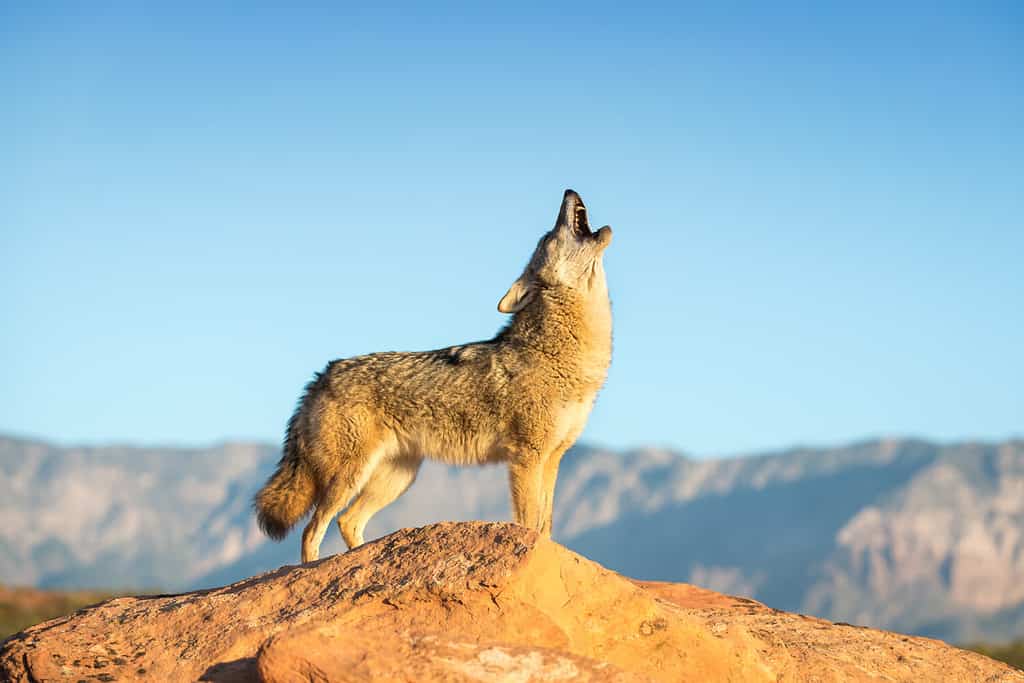Coyotes are native to North America, where they have had a complicated relationship with humans for thousands of years. Some Native American tribes revered coyotes for their intelligence. However, farmers have historically considered coyotes to be pests due to their ability to raid animal enclosures. Coyotes are abundant in the western United States, including the Centennial State. Keep reading to learn all about coyotes in Colorado, including where they’re found, hunting regulations, and more.

Coyotes produce a range of vocalizations, including howls and unique “yipping” sounds.
©Warren Metcalf/Shutterstock.com
Overview of Coyotes
Coyotes live throughout Northern and Central America, from Canada to Panama, where they have adapted to live in a variety of habitats.
Appearance
As members of the Canidae family, coyotes have a dog-like appearance with lean bodies, long tails, and distinctive, large ears. Coyotes have thick, shaggy fur that is typically brown, grey, or yellow, with lighter fur on their stomachs and throats. On average, coyotes weigh 20-50 pounds and are about the size of a medium dog.

Coyotes can reach a top speed of 40 miles per hour.
©Dennis Laughlin/Shutterstock.com
Diet
Coyotes are opportunistic omnivores and can adapt their diet based on food availability. They are most often nocturnal, preferring to hunt during the night, although they will hunt during the daytime hours in the wintertime. Their diet largely consists of small animals, such as squirrels and rabbits, but they will also hunt larger animals, such as deer. On average, coyotes can reach speeds of 35 miles per hour, enabling them to chase down fast-moving prey.
When animals aren’t available for coyotes to hunt, they will turn to plants or even carrion. In addition, coyotes will eat livestock, chickens, and domestic pets. They have learned to scavenge through human garbage in search of food.
Behavior
As social animals, coyotes tend to stay in pairs or family units. Larger packs of coyotes are unusual except in areas with enough prey to sustain a group. Coyotes communicate with each other using a wide range of vocalizations that include barks, growls, howls, or yips.
Often, coyotes will stay with their mates for life. Matched pairs travel and hunt together, producing one litter a year. Both parents care for and feed their pups, which take about six to nine months to reach maturity. Grown male coyotes typically leave the family unit, although females will sometimes remain.
Coyotes are not typically aggressive towards humans. Researchers have documented around 360 instances of coyotes attacking humans from 1977-2015. Children and toddlers are at a higher risk of attack than adults, and researchers additionally noted an increase in domestic pet attacks during this period.

Coyote pups stay with their family pack until they’re at least six to nine months old.
©iStock.com/roclwyr
Coyotes in Colorado
There are around 80,000 to 90,000 coyotes in Colorado today. This number represents a significant increase after coyotes were hunted to near extinction by farmers in the early 1900s.
As human settlements encroached on their territory, coyotes were seen as a significant threat to livestock and farm animals. However, coyote numbers have recovered, thanks in part to dwindling numbers of bears and wolves, which are among their only natural predators.
Habitat
Coyotes can be found throughout Colorado. While they typically prefer open deserts or prairies, coyotes can also adapt to more urban environments. They use their strong claws to create underground dens, although they will frequently use burrows created by other animals and simply enlarge them. However, coyotes are endlessly adaptable and can find shelter in bushes, hollow logs, and along rocky slopes.

Coyotes prefer to live in deserts and open prairies but have adapted to a wide variety of habitats.
©fusaromike/iStock via Getty Images
Hunting Coyotes
Colorado has over 20 million acres of public land and a strong tradition of hunting and outdoor recreation. Hunting is regulated by Colorado Parks and Wildlife, which permits coyote hunting year-round. Although coyotes are considered a fur-bearing animal, hunters are not required to carry a furbearer license.
Colorado Parks and Wildlife permits coyote hunting with a small game license, furbearer license, or an unused big game license. In addition, hunters must register with the Harvest Information Program.
There are no bag limits or possession limits for coyotes in Colorado. It is legal to hunt coyotes at night, and hunters may use any type of shotgun, rifle, handgun, crossbow, handheld bow, or live traps.
Living With Coyotes
Although coyotes are elusive, they leave behind tracks and droppings in the areas they inhabit. Their nighttime howls can also alert humans to their presence.
In places where human and coyote habitats overlap, Colorado Parks and Wildlife recommends that residents take steps to protect their pets. Dogs and cats should be kept inside, especially overnight. Fences should be at least six feet tall to prevent coyotes from entering, and if possible, provide outdoor animals with an enclosed structure for safety.
Avoid leaving pet food outside, and be sure that any household garbage is secure. Coyotes are capable hunters, but they are also opportunistic and will eat food they find available.
In situations where a coyote approaches a human, experts recommend staying calm and slowly backing away. If the coyote continues to advance, make loud noises by clapping or yelling. If possible, throw sticks or rocks to frighten the coyote away. Continue to back away from the animal until it disengages or you’ve reached a safe area.
The photo featured at the top of this post is © Steve Byland/Shutterstock.com
